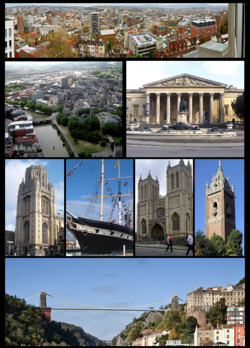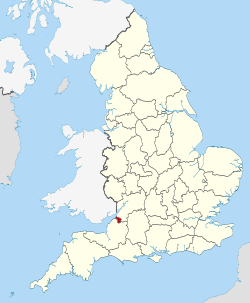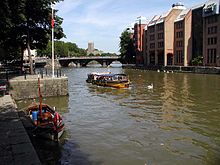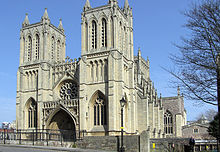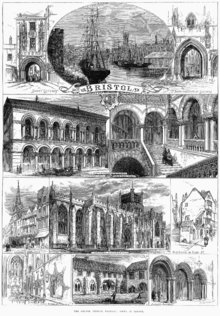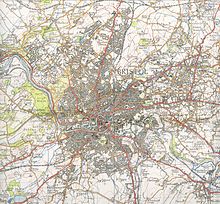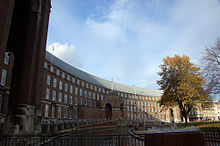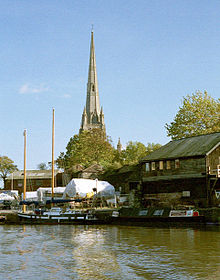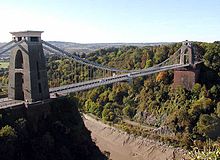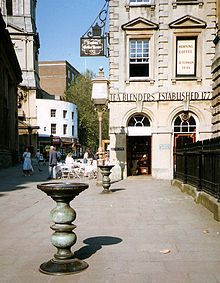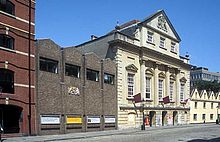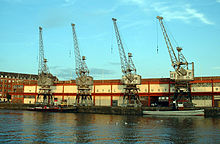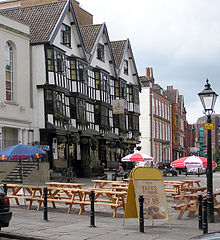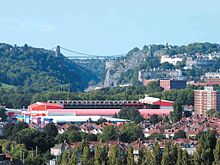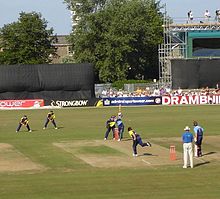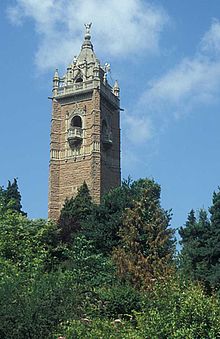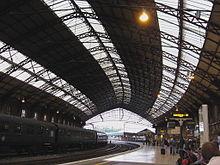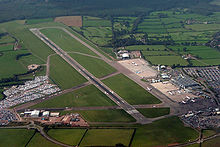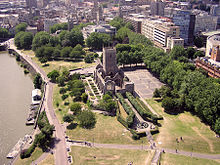
Bristol
Background to the schools Wikipedia
SOS Children offer a complete download of this selection for schools for use on schools intranets. SOS Child sponsorship is cool!
| Bristol | |||
|---|---|---|---|
| — Unitary, City, Ceremonial county — | |||
| Montage of Bristol | |||
|
|||
| Motto: "Virtute et Industria" "By Virtue and Industry" | |||
| Coordinates: 51°27′N 2°35′W | |||
| Sovereign state | United Kingdom | ||
| Constituent country | England | ||
| Region | South West England | ||
| Ceremonial county | Bristol ( County corporate) |
||
| Admin HQ | Bristol | ||
| Royal Charter | 1155 | ||
| County status | 1373 | ||
| Government | |||
| • Type | Unitary authority, City | ||
| • Governing body | Bristol City Council | ||
| • Leadership | Mayor and Cabinet | ||
| • Mayor | George Ferguson | ||
| • MPs | Chris Skidmore (C) Kerry McCarthy (L) |
||
| Area | |||
| • Unitary, City, Ceremonial county | 40 sq mi (110 km2) | ||
| Elevation | 36 ft (11 m) | ||
| Population (2011 est.) | |||
| • Unitary, City, Ceremonial county | 428,100 (Ranked 10th amongst English Districts / 43rd amongst Ceremonial Counties) | ||
| • Density | 9,420/sq mi (3,639/km2) | ||
| • Urban | 587,400 (2,006 ONS estimate) | ||
| • Metro | 1,006,600 ( LUZ2,009) | ||
| • Ethnicity | 84.0% White (77.9% White British) 5.5% Asian 6.0% Black 3.6% Mixed Race 0.3% Arab 0.6% Other |
||
| Time zone | GMT ( UTC0) | ||
| Postcode | BS | ||
| Area code(s) | 0117 | ||
| ISO 3166 code | GB-BST | ||
| ONS code | 00HB (ONS) E06000023 (GSS) |
||
| OS grid reference | ST595726 | ||
| NUTS 3 | UKK11 | ||
| Website | bristol.gov.uk/ | ||
Bristol / ˈ b r ɪ s t əl / is a city, unitary authority area and ceremonial county in South West England, with an estimated population of 433,100 for the unitary authority in 2009, and a surrounding Larger Urban Zone (LUZ) with an estimated 1,070,000 residents in 2007. It is England's sixth and the United Kingdom's eighth most populous city, one of the Core Cities Group and the most populous city in South West England.
Historically split between Gloucestershire and Somerset, the city received a Royal charter in 1155 and was granted County status in 1373. From the 13th century, for half a millennium, it ranked amongst the top three English cities after London, alongside York and Norwich, on the basis of tax receipts, until the rapid rise of Liverpool, Birmingham and Manchester during the Industrial Revolution in the latter part of the 18th century. It borders the counties of Somerset and Gloucestershire, and is also located near the historic cities of Bath to the south east and Gloucester to the north. The city is built around the River Avon, and it also has a short coastline on the Severn Estuary, which flows into the Bristol Channel.
Bristol is the largest centre of culture, employment and education in the region. Its prosperity has been linked with the sea since its earliest days. The commercial Port of Bristol was originally in the city centre before being moved to the Severn Estuary at Avonmouth; Royal Portbury Dock is on the western edge of the city boundary. In more recent years the economy has depended on the creative media, electronics and aerospace industries, and the city centre docks have been regenerated as a centre of heritage and culture. There are 34 other populated places on Earth named Bristol, most in the United States, but also in Peru, Canada, Jamaica, Barbados, and Costa Rica, all presumably commemorating the original.
People from Bristol are termed Bristolians.
History
Archaeological finds believed to be 60,000 years old, discovered at Shirehampton and St Annes, provide "evidence of human activity" in the Bristol area from the Palaeolithic era. Iron Age hill forts near the city are at Leigh Woods and Clifton Down on the side of the Avon Gorge, and on Kingsweston Hill, near Henbury. During the Roman era there was a settlement, Abona, at what is now Sea Mills, connected to Bath by a Roman road, and another at the present-day Inns Court. There were also isolated Roman villas and small Roman forts and settlements throughout the area.
The town of Brycgstow (Old English, "the place at the bridge") appears to have been founded in c.1000 and by c.1020 was an important enough trading centre to possess its own mint, producing silver pennies bearing the town's name. By 1067 the town was clearly a well fortified burh that proved capable of resisting an invasion force sent from Ireland by Harold's sons. Under Norman rule the town acquired one of the strongest castles in southern England.
The area around the original junction of the River Frome with the River Avon, adjacent to the original Bristol Bridge and just outside the town walls, was where the port began to develop in the 11th century. By the 12th century Bristol was an important port, handling much of England's trade with Ireland, including slaves. In 1247 a new stone bridge was built, which was replaced by the current Bristol Bridge in the 1760s, and the town was extended to incorporate neighbouring suburbs, becoming in 1373 a county in its own right. During this period Bristol also became a centre of shipbuilding and manufacturing. By the 14th century Bristol was one of England's three largest medieval towns after London, along with York and Norwich, and it has been suggested that between a third and half of the population were lost during the Black Death of 1348–49. The plague resulted in a prolonged pause in the growth of Bristol's population, with numbers remaining at 10,000–12,000 through most of the 15th and 16th centuries.
In the 15th century, Bristol was the second most important port in the country, trading to Ireland, Iceland, and Gascony. Bristol was the starting point for many important voyages, including that led by Robert Sturmy (1457–58) to try to break the Italian monopoly over trade to the Eastern Mediterranean. Having been rebuffed in the east, Bristol merchants turned west, being involved in expeditions into the Atlantic, in search of the Isle of Hy-Brazil, by at least 1480. These Atlantic voyages were to culminate in John Cabot's 1497 voyage of exploration to North America and the subsequent expeditions undertaken by Bristol merchants to the new world up to 1508. These include one led by William Weston of Bristol in 1499, which was the first English-led expedition to North America. In the sixteenth century, however, Bristol merchants concentrated on developing their trade to Spain and its American colonies. This included the smuggling of 'prohibited' wares, such as foodstuffs and guns, to Iberia, even during the Anglo-Spanish war of 1585–1604. Indeed, the scale of the city's illicit trade grew enormously after 1558, to become an essential component of the city's economy.
The Diocese of Bristol was founded in 1542, with the former Abbey of St. Augustine, founded by Robert Fitzharding in 1140, becoming Bristol Cathedral. Traditionally this is equivalent to the town being granted city status. During the 1640s English Civil War the city was occupied by Royalist military, and they built the Royal Fort House on the site of an earlier Parliamentarian stronghold.
Renewed growth came with the 17th century rise of England's American colonies and the rapid 18th century expansion of England's part in the Atlantic trade in Africans taken for slavery in the Americas. Bristol, along with Liverpool, became a centre for the Triangular trade. In the first stage of this trade manufactured goods were taken to West Africa and exchanged for Africans who were then, in the second stage or middle passage, transported across the Atlantic in brutal conditions. The third leg of the triangle brought plantation goods such as sugar, tobacco, rum, rice and cotton and also a small number of slaves who were sold to the aristocracy as house servants, some eventually buying their freedom. During the height of the slave trade, from 1700 to 1807, more than 2,000 slaving ships were fitted out at Bristol, carrying a (conservatively) estimated half a million people from Africa to the Americas and slavery.
The Seven Stars public house, where abolitionist Thomas Clarkson collected information on the slave trade, still exists.
Fishermen from Bristol had fished the Grand Banks of Newfoundland since the 15th century and began settling Newfoundland permanently in larger numbers in the 17th century establishing colonies at Bristol's Hope and Cuper's Cove. Bristol's strong nautical ties meant that maritime safety was an important issue in the city. During the 19th century Samuel Plimsoll, "the sailor's friend", campaigned to make the seas safer; he was shocked by the overloaded cargoes, and successfully fought for a compulsory load line on ships.
Competition from Liverpool from c. 1760, the disruption of maritime commerce caused by wars with France (1793) and the abolition of the slave trade (1807) contributed to the city's failure to keep pace with the newer manufacturing centres of the North of England and the West Midlands. The passage up the heavily tidal Avon Gorge, which had made the port highly secure during the Middle Ages, had become a liability which the construction of a new " Floating Harbour" (designed by William Jessop) in 1804–9 failed to overcome, as the great cost of the scheme led to excessive harbour dues. Nevertheless, Bristol's population (66,000 in 1801) quintupled during the 19th century, supported by new industries and growing commerce. It was particularly associated with the noted Victorian engineer, Isambard Kingdom Brunel, who designed the Great Western Railway between Bristol and London Paddington, two pioneering Bristol-built ocean going steamships, the SS Great Britain and SS Great Western, and the Clifton Suspension Bridge. John Wesley founded the very first Methodist Chapel, called the New Room, in Bristol in 1739. Riots occurred in 1793 and 1831, the first beginning as a protest at renewal of an act levying tolls on Bristol Bridge, and the latter after the rejection of the second Reform Bill.
By 1901, some 330,000 people were living in Bristol and the city would grow steadily as the 20th century progressed. The city's docklands were enhanced in the early 1900s with the opening of Royal Edward Dock. Another new dock – Royal Portbury Dock – was opened in the 1970s.
Its education system received a major boost in 1909 with the formation of the University of Bristol, though it really took off in 1925 when its main building was opened. A polytechnic was opened in 1969 to give the city a second higher education institute, which would become the University of the West of England in 1992. With the advent of air travel, aircraft manufacturers set up base at new factories in the city during the first half of the 20th century.
Bristol suffered badly from Luftwaffe air raids in World War II, claiming some 1,300 lives of people living and working in the city, with nearly 100,000 buildings being damaged, at least 3,000 of them beyond repair. The original central shopping area, near the bridge and castle, is now a park containing two bombed out churches and some fragments of the castle. A third bombed church nearby, St Nicholas, has been restored and has been made into a museum which houses a triptych by William Hogarth, painted for the high altar of St Mary Redcliffe in 1756. The museum also contains statues moved from Arno's Court Triumphal Arch, of King Edward I and King Edward III taken from Lawfords' Gate of the city walls when they were demolished around 1760, and 13th century figures from Bristol's Newgate representing Robert, the builder of Bristol Castle, and Geoffrey de Montbray, Bishop of Coutances, builder of the fortified walls of the city.
The rebuilding of Bristol city centre was characterised by large, cheap 1960s tower blocks, brutalist architecture and expansion of roads. Since the 1980s another trend has emerged with the closure of some main roads, the restoration of the Georgian era Queen Square and Portland Square, the regeneration of the Broadmead shopping area, and the demolition of one of the city centre's tallest post-war blocks.
Bristol's road infrastructure was altered dramatically in the 1960s and 1970s with the development of the M4 and M5 motorways, which meet at an interchange just north of the city and give the city direct motorway links with London (M4 eastbound), Cardiff (M4 westbound across the Estuary of the River Severn), Exeter (M5 southbound) and Birmingham (M5 northbound).
The removal of the docks to Avonmouth Docks and Royal Portbury Dock, 7 miles (11.3 km) downstream from the city centre during the 20th century has also allowed redevelopment of the old central dock area (the "Floating Harbour") in recent decades, although at one time the continued existence of the docks was in jeopardy as it was viewed as a derelict industrial site rather than an asset. However the holding, in 1996, of the first International Festival of the Sea in and around the docks, affirmed the dockside area in its new leisure role as a key feature of the city.
On the sporting scene, Bristol Rugby union club has frequently competed at the highest level in the sport since its formation in 1888. Its home is the Memorial Ground, which it has shared with Bristol Rovers Football Club since 1996. Although the rugby club was landlord when the football club arrived at the stadium as tenants, a decline in the rugby club's fortunes shortly afterwards led to the football club becoming landlord and the rugby club becoming the stadium's tenants. Bristol Rovers had spent the previous 10 years playing their home games outside the city following the closure of their Eastville stadium in 1986, before returning to the city to play at the Memorial Ground.
However, Bristol Rovers have generally been overshadowed by their local rivals Bristol City in terms of footballing success. Unlike Rovers, City have enjoyed top flight football. Their first spell in the Football League First Division began in 1906, and they ended their first season among the elite in fine form by finishing second and only narrowly missing out on league title glory. Two years later, they were on the losing side in the final of the FA Cup, and were relegated back to the Football League Second Division two years later. It would be another 65 years before First Division status was regained, in 1976. This time they spent four years among the elite before being relegated in 1980 – the first of a then unique three successive relegations which led to them slipping into the Fourth Division in 1982. Although promotion was secured in 1984, City enjoyed their seventh spell in the league's third tier until 2007 when they were promoted to the second tier, narrowly missing out on top flight promotion in their first season (Playoff final defeat against Hull City) English football. Since 1900 their home games have been played at Ashton Gate, though in recent years a number of schemes have been mooted to relocate the club to a new, larger stadium.
Government
Bristol City Council consists of 70 councillors representing 35 wards. They are elected in thirds with two councillors per ward, each serving a four-year term. Wards never have both councillors up for election at the same time, so effectively two-thirds of the wards are up each election. The Council has long been dominated by the Labour Party, but recently the Liberal Democrats have grown strong in the city and as the largest party took minority control of the Council at the 2005 election. In 2007, Labour and the Conservatives joined forces to vote down the Liberal Democrat administration, and as a result, Labour ruled the council under a minority administration, with Helen Holland as the council leader. In February 2009, the Labour group resigned, and the Liberal Democrats took office with their own minority administration. At the council elections on 4 June 2009 the Liberal Democrats gained four seats and, for the first time, overall control of the City Council. The Lord Mayor is Councillor Peter Main. The most recent City council elections were in May 2011. The next are expected in May 2013. On 3 May 2012, Bristol held a referendum to decide whether the city should have a directly elected mayor to replace the leader elected by councillors. The result was announced on 4 May. 41,032 voted for an elected mayor and 35,880 voted against, with a turnout of 24%. An election for the new post was held on 15 November 2012 with Independent candidate George Ferguson becoming Mayor of Bristol.
Bristol constituencies in the House of Commons cross the borders with neighbouring authorities, and the city is divided into Bristol West, East, South and North-west. In the recent 2010 General Election in May, the boundaries were changed to coincide with the county boundary. There are two Labour Members of Parliament (MPs), one Liberal Democrat and one Conservative.
After the 2010 British General election, the new political representation the city was composed of two Labour MPs, and one MP each for the Lib Dems and the Conservatives. The Conservatives gained Bristol North-West from the Labour Party.
Bristol has a tradition of local political activism, and has been home to many important political figures. Edmund Burke, MP for the Bristol constituency for six years from 1774, famously insisted that he was a Member of Parliament first, rather than a representative of his constituents' interests. The women's rights campaigner Emmeline Pethick-Lawrence (1867–1954) was born in Bristol. Tony Benn, a veteran left-wing politician, was MP for Bristol South East from 1950 to 1960 and again from 1963 until 1983. In 1963, there was a boycott of the city's buses after the Bristol Omnibus Company refused to employ black drivers and conductors. The boycott is known to have influenced the creation of the UK's Race Relations Act in 1965. The city was the scene of the first of the 1980s riots. In St. Paul's, a number of largely Afro-Caribbean people rose up against racism, police harassment and mounting dissatisfaction with their social and economic circumstances before similar disturbances followed across the UK. Local support of fair trade issues was recognised in 2005 when Bristol was granted Fairtrade City status.
Bristol is unusual in having been a city with county status since medieval times. The county was expanded to include suburbs such as Clifton in 1835, and it was named a county borough in 1889, when the term was first introduced. However, on 1 April 1974, it became a local government district of the short-lived county of Avon. On 1 April 1996, it regained its independence and county status, when the county of Avon was abolished and Bristol became a Unitary authority.
Geography and environment
Boundaries
There are a number of different ways in which Bristol's boundaries are defined, depending on whether the boundaries attempt to define the city, the built-up area, or the wider " Greater Bristol". The narrowest definition of the city is the city council boundary, which takes in a large section of the Severn Estuary west as far as, but not including, the islands of Steep Holm and Flat Holm. A slightly less narrow definition is used by the Office for National Statistics (ONS); this includes built-up areas which adjoin Bristol but are not within the city council boundary, such as Whitchurch village, Filton, Patchway, Bradley Stoke, and excludes non-built-up areas within the city council boundary. The ONS has also defined an area called the "Bristol Urban Area," which includes Kingswood, Mangotsfield, Stoke Gifford, Winterbourne, Frampton Cotterell, Almondsbury and Easton in Gordano. The term "Greater Bristol", used for example by the Government Office of the South West, usually refers to the area occupied by the city and parts of the three neighbouring local authorities ( Bath and North East Somerset, North Somerset and South Gloucestershire), an area sometimes also known as the "former Avon area" or the " West of England". The North Fringe of Bristol, a largely developed area within South Gloucestershire, located between the Bristol city boundary and the M4 and M5 motorways, was so named as part of a 1987 Local plan prepared by Northavon District Council.

Physical geography
Bristol is in a limestone area, which runs from the Mendip Hills to the south and the Cotswolds to the north east. The rivers Avon and Frome cut through this limestone to the underlying clays, creating Bristol's characteristic hilly landscape. The Avon flows from Bath in the east, through flood plains and areas which were marshy before the growth of the city. To the west the Avon has cut through the limestone to form the Avon Gorge, partly aided by glacial meltwater after the last ice age. The gorge helped to protect Bristol Harbour, and has been quarried for stone to build the city. The land surrounding the gorge has been protected from development, as The Downs and Leigh Woods. The gorge and estuary of the Avon form the county's boundary with North Somerset, and the river flows into the Severn Estuary at Avonmouth. There is another gorge in the city, in the Blaise Castle estate to the north.
Climate
Situated in the south of the country, Bristol is one of the warmest cities in the UK, with a mean annual temperature of 10.2–12 °C (50–54 °F). It is also amongst the sunniest, with 1,541–1,885 hours sunshine per year. The city is partially sheltered by the Mendip Hills, but exposed to the Severn Estuary and Bristol Channel. Rainfall increases towards the south of the area, with annual totals north of the Avon River in the 600-900 mm (35 in) range, up to the 900-1,200 mm (47 in) range South of it. Rain falls all year round, but autumn and winter are the wettest seasons.
The Atlantic strongly influences Bristol's weather, maintaining average temperatures above freezing throughout the year, although cold spells in winter often bring frosts. Snow can fall at any time from early November through to late April, but it is an infrequent occurrence. Summers are drier and quite warm with variable amounts of sunshine, rain and cloud. Spring is unsettled and changeable, and has brought spells of winter snow as well as summer sunshine.
The nearest weather stations to Bristol for which long term climate data are available are Long Ashton (about 5 miles South West of the city centre) and Bristol Weather Station (Within the city centre). However, data collection at these locations ceased in 2002 and 2001 respectively, and Filton Airfield is now the closest Weather Station. The temperature range at Long Ashton for the period 1959–2002 has spanned from 33.5 °C (92.3 °F) during July 1976, down to −14.4 °C (6.1 °F) in January 1982. Monthly Temperature extremes at Filton (since 2002) exceeding those recorded at Long Ashton include 25.7 °C (78.3 °F) during April 2003, 34.5 °C (94.1 °F) during July 2006 and 26.8 °C (80.2 °F) in October 2011. The lowest temperature recorded in recent years at Filton was −10.1 °C (13.8 °F) during December 2010.
As can be seen from the charts below, like many large cities, Bristol experiences an urban heat island effect, with night time averages at Bristol Weather Centre, in the city centre generally being just under 2 °C milder than Long Ashton, just outside the urban area.
| Climate data for Bristol Weather Centre 11 m asl, 1971–2000 | |||||||||||||
|---|---|---|---|---|---|---|---|---|---|---|---|---|---|
| Month | Jan | Feb | Mar | Apr | May | Jun | Jul | Aug | Sep | Oct | Nov | Dec | Year |
| Average high °C (°F) | 7.5 (45.5) |
7.4 (45.3) |
10.1 (50.2) |
12.7 (54.9) |
16.5 (61.7) |
18.9 (66) |
22.0 (71.6) |
21.0 (69.8) |
18.4 (65.1) |
14.7 (58.5) |
10.5 (50.9) |
8.9 (48) |
14.1 (57.4) |
| Average low °C (°F) | 3.8 (38.8) |
2.9 (37.2) |
4.9 (40.8) |
5.6 (42.1) |
9.0 (48.2) |
11.9 (53.4) |
14.3 (57.7) |
14.0 (57.2) |
12.0 (53.6) |
9.7 (49.5) |
6.3 (43.3) |
5.3 (41.5) |
8.3 (46.9) |
| Precipitation mm (inches) | 73 (2.87) |
48 (1.89) |
51 (2.01) |
52 (2.05) |
54 (2.13) |
64 (2.52) |
64 (2.52) |
52 (2.05) |
50 (1.97) |
59 (2.32) |
52 (2.05) |
59 (2.32) |
626.8 (24.677) |
| Source: MeteoFrance | |||||||||||||
| Climate data for Long Ashton 51 m asl, 1971–2000, extremes 1959–2002 (Sunshine 1971–1989) | |||||||||||||
|---|---|---|---|---|---|---|---|---|---|---|---|---|---|
| Month | Jan | Feb | Mar | Apr | May | Jun | Jul | Aug | Sep | Oct | Nov | Dec | Year |
| Record high °C (°F) | 14.2 (57.6) |
18.3 (64.9) |
21.7 (71.1) |
23.0 (73.4) |
26.5 (79.7) |
32.4 (90.3) |
33.5 (92.3) |
33.3 (91.9) |
28.3 (82.9) |
26.1 (79) |
17.5 (63.5) |
15.8 (60.4) |
33.5 (92.3) |
| Average high °C (°F) | 7.5 (45.5) |
7.7 (45.9) |
10.0 (50) |
12.4 (54.3) |
16.0 (60.8) |
18.7 (65.7) |
21.1 (70) |
20.7 (69.3) |
17.9 (64.2) |
14.1 (57.4) |
10.5 (50.9) |
8.3 (46.9) |
13.74 (56.74) |
| Average low °C (°F) | 2.1 (35.8) |
1.8 (35.2) |
3.4 (38.1) |
4.5 (40.1) |
7.3 (45.1) |
10.2 (50.4) |
12.4 (54.3) |
12.2 (54) |
10.2 (50.4) |
7.4 (45.3) |
4.5 (40.1) |
3.0 (37.4) |
6.58 (43.85) |
| Record low °C (°F) | −14.4 (6.1) |
−9.7 (14.5) |
−8.3 (17.1) |
−4.7 (23.5) |
−2.0 (28.4) |
0.6 (33.1) |
4.7 (40.5) |
3.9 (39) |
0.6 (33.1) |
−3.2 (26.2) |
−6.5 (20.3) |
−11.9 (10.6) |
−14.4 (6.1) |
| Precipitation mm (inches) | 94.36 (3.715) |
65.47 (2.5776) |
73.73 (2.9028) |
50.46 (1.9866) |
61.30 (2.4134) |
68.33 (2.6902) |
52.23 (2.0563) |
75.02 (2.9535) |
85.95 (3.3839) |
92.08 (3.6252) |
91.62 (3.6071) |
102.78 (4.0465) |
913.33 (35.9581) |
| Mean monthly sunshine hours | 50.53 | 66.39 | 108.19 | 165.3 | 192.82 | 198.0 | 208.01 | 196.23 | 147.9 | 97.65 | 64.8 | 43.09 | 1,538.91 |
| Source #1: Met Office | |||||||||||||
| Source #2: Royal Dutch Meteorological Institute date=July 2012 |
|||||||||||||
Environment
Based on its environmental performance, quality of life, future-proofing and how well it is addressing climate change, recycling and biodiversity, Bristol was ranked as Britain's most sustainable city, topping environmental charity Forum for the Future's Sustainable Cities Index 2008. Notable local initiatives include Sustrans, who have created the National Cycle Network, founded as Cyclebag in 1977, and Resourcesaver established in 1988 as a non-profit business by Avon Friends of the Earth.
Demographics
In 2008 the Office for National Statistics estimated the Bristol unitary authority's population at 416,900, making it the 47th-largest ceremonial county in England. Using Census 2001 data the ONS estimated the population of the city to be 441,556, and that of the contiguous urban area to be 551,066. and more recent 2006 ONS estimates put the urban area population at 587,400. This makes the city England's sixth most populous city, and ninth most populous urban area. At 3,599 inhabitants per square kilometre (9,321 /sq mi) it has the seventh-highest population density of any English district.
According to the 2011 census, 84.0% of the population was White (77.9% White British, 0.9% White Irish, 0.1% Gypsy or Irish Travellers, 5.1% Other White), 3.6% of mixed race (1.7% White and Black Caribbean, 0.4% White and Black African, 0.8% White and Asian, 0.7% Other Mixed), 5.5% Asian (1.5% Indian, 1.6% Pakistani, 0.5% Bangladeshi, 0.9% Chinese, 1.0% Other Asian), 6.0% Black (2.8% African, 1.6% Caribbean, 1.6% Other Black), 0.3% Arab and 0.6% of other ethnic heritage. Bristol is unusual among major British towns and cities in having a larger Black than Asian population. At 1.2%, it has the highest proportion of Somali-born residents of any city in the country and of any local authority outside of London, and the third-highest Somali-born population in absolute terms behind London and Birmingham.
Historical population records
Note: Only includes figures for Bristol Unitary Authority i.e. excludes areas that are part of the Bristol urban area (2006 estimated population 587,400) but are located in South Gloucestershire, BANES or North Somerset which border Bristol UA such as Kingswood, Mangotsfield, Filton, Warmley etc. The figures for 2008, 2009 & 2010 are an estimate from the Office for National Statistics.
| Year | 1377 | 1607 | 1700 | 1801 | 1811 | 1821 | 1831 | 1841 | 1851 | |
| Total population | 9,518 | 10,549 | 20,000 | 68,944 | 83,922 | 99,151 | 120,789 | 144,803 | 159,945 | |
| Year | 1861 | 1871 | 1881 | 1891 | 1901 | 1911 | 1921 | 1931 | 1941 | |
| Total population | 194,229 | 228,513 | 262,797 | 297,525 | 323,698 | 352,178 | 367,831 | 384,204 | 402,839 | |
| Year | 1951 | 1961 | 1971 | 1981 | 1991 | 2001 | 2008 | 2009 | 2010 | |
| Total population | 422,399 | 425,214 | 428,089 | 384,883 | 396,559 | 380,615 | 426,100 | 433,100 | 441,300 | |
Economy and industry
As a major seaport, Bristol has a long history of trading commodities, originally wool cloth exports and imports of fish, wine, grain and dairy produce, later tobacco, tropical fruits and plantation goods; major imports now are motor vehicles, grain, timber, fresh produce and petroleum products. Deals were originally struck on a personal basis in the former trading area around The Exchange in Corn Street, and in particular, over bronze trading tables, known as " The Nails". This is often given as the origin of the expression "cash on the nail", meaning immediate payment, however it is likely that the expression was in use before the nails were erected.
As well as Bristol's nautical connections, the city's economy is reliant on the aerospace industry, defence, the media, information technology and financial services sectors, and tourism. The former Ministry of Defence (MoD)'s Procurement Executive, later the Defence Procurement Agency, and now Defence Equipment and Support, moved to a purpose-built headquarters at Abbey Wood, Filton in 1995. The site employs some 7,000 to 8,000 staff and is responsible for procuring and supporting much of the MoD's defence equipment.
In 2004 Bristol's GDP was £9.439 billion, and the combined GDP of Gloucestershire, Wiltshire and North Somerset was £44.098 billion. The GDP per head was £23,962 (US$47,738, €35,124) making the city more affluent than the UK as a whole, at 40% above the national average. This makes it the third-highest per-capita GDP of any English city, after London and Nottingham, and the fifth highest GDP per capita of any city in the United Kingdom, behind London, Edinburgh, Glasgow, Belfast and Nottingham. In March 2007, Bristol's unemployment rate was 4.8%, compared with 4.0% for the south west and 5.5% for England.
Although Bristol's economy is no longer reliant upon the Port of Bristol, which was relocated gradually to the mouth of the Avon to new docks at Avonmouth (1870s) and Royal Portbury Dock (1977) as the size of shipping increased, the city is the largest importer of cars to the UK. Since the port was leased in 1991, £330 million has been invested and the annual tonnage throughput has increased from 3.9 million long tons (4 million tonnes) to 11.8 million long tons (12 million tonnes). The tobacco trade and cigarette manufacturing have now ceased, but imports of wines and spirits by Averys continue.
The financial services sector employs 59,000 in the city, and the high tech sector is important, with 50 micro-electronics and silicon design companies, which employ around 5,000 people, including the Hewlett-Packard national research laboratories, which opened in 1983. Bristol is the UK's seventh most popular destination for foreign tourists, and the city receives nine million visitors each year.
In the 20th century, Bristol's manufacturing activities expanded to include aircraft production at Filton, by the Bristol Aeroplane Company, and aero-engine manufacture by Bristol Aero Engines (later Rolls-Royce) at Patchway. The aeroplane company became famous for the World War I Bristol Fighter, and Second World War Blenheim and Beaufighter aircraft. In the 1950s it became one of the country's major manufacturers of civil aircraft, with the Bristol Freighter and Britannia and the huge Brabazon airliner. The Bristol Aeroplane Company diversified into car manufacturing in the 1940s, producing hand-built luxury cars at their factory in Filton, under the name Bristol Cars, which became independent from the Bristol Aeroplane Company in 1960. The city also gave its name to the Bristol make of buses, manufactured in the city from 1908 to 1983, first by the local bus operating company, Bristol Tramways, and from 1955 by Bristol Commercial Vehicles.
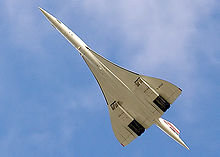
In the 1960s Filton played a key role in the Anglo-French Concorde supersonic airliner project. The Bristol Aeroplane Company became part of the British partner, the British Aircraft Corporation (BAC). Concorde components were manufactured in British and French factories and shipped to the two final assembly plants, in Toulouse and Filton. The French manufactured the centre fuselage and centre wing and the British the nose, rear fuselage, fin and wingtips, while the Olympus 593 engine's manufacture was split between Rolls-Royce (Filton) and Snecma (Paris). The British Concorde prototype made its maiden flight from Filton to RAF Fairford on 9 April 1969, five weeks after the French test flight. In 2003 British Airways and Air France decided to cease flying the aircraft and to retire them to locations (mostly museums) around the world. On 26 November 2003 Concorde 216 made the final Concorde flight, returning to Filton airfield to be kept there permanently as the centrepiece of a projected air museum. This museum will include the existing Bristol Aero Collection, which includes a Bristol Britannia aircraft.
The aerospace industry remains a major segment of the local economy. The major aerospace companies in Bristol now are BAE Systems, (formed by merger between Marconi Electronic Systems and BAe; the latter being formed by a merger of BAC, Hawker Siddeley and Scottish Aviation), Airbus and Rolls-Royce are all based at Filton, and aerospace engineering is a prominent research area at the nearby University of the West of England. Another important aviation company in the city is Cameron Balloons, who manufacture hot air balloon. Each August the city is host to the Bristol International Balloon Fiesta, one of Europe's largest hot air balloon events.
A new £500 million shopping centre called Cabot Circus opened in 2008 amidst claims from developers and politicians that Bristol would become one of England's top ten retail destinations. Bristol was selected as one of the world's top ten cities for 2009 by international travel publishers Dorling Kindersley in their Eyewitness series of guides for young adults.
In 2011 it was announced that the Temple Quarter near Bristol Temple Meads railway station will become an enterprise zone.
Culture
Arts
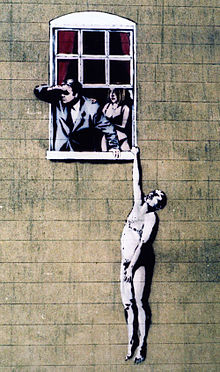
The city is famous for its music and film industries, and was a finalist for the 2008 European Capital of Culture, but the title was awarded to Liverpool.
Bristol is also home to street art event See No Evil, which started in 2011.
Bristol is home to one of the seven national Foodies Festivals, taking place 13–15 July 2012, and including masterclasses from Levi Roots and Ed Baines, as well as city beaches, restaurant tents, pop-up cinemas and burlesque shows. The city's principal theatre company, the Bristol Old Vic, was founded in 1946 as an offshoot of The Old Vic company in London. Its premises on King Street consist of the 1766 Theatre Royal (607 seats), a modern studio theatre called the New Vic (150 seats), and foyer and bar areas in the adjacent Coopers' Hall (built 1743). The Theatre Royal is a grade I listed building and is the oldest continuously operating theatre in England. The Bristol Old Vic Theatre School, which had originated in King Street is now a separate company. The Bristol Hippodrome is a larger theatre (1,951 seats) which hosts national touring productions. Other theatres include the Tobacco Factory (250 seats), QEH (220 seats), the Redgrave Theatre (at Clifton College) (320 seats) and the Alma Tavern (50 seats). Bristol's theatre scene includes a large variety of producing theatre companies, apart from the Bristol Old Vic company, including Show of Strength Theatre Company, Shakespeare at the Tobacco Factory and Travelling Light Theatre Company. Theatre Bristol is a partnership between Bristol City Council, Arts Council England and local theatre practitioners which aims to develop the theatre industry in Bristol. There are also a number of organisations within the city which act to support theatre makers, for example Equity, the actors union, has a General Branch based in the city, and Residence which provides office, social and rehearsal space for several Bristol-based theatre and performance companies.
Since the late 1970s, the city has been home to bands combining punk, funk, dub and political consciousness, amongst the most notable have been Glaxo Babies, The Pop Group and trip hop or " Bristol Sound" artists such as Tricky, Portishead and Massive Attack; the list of bands from Bristol is extensive. It is also a stronghold of drum and bass with notable artists such as the Mercury Prize winning Roni Size/ Reprazent as well as the pioneering DJ Krust and More Rockers. This music is part of the wider Bristol urban culture scene which received international media attention in the 1990s. Bristol has many live music venues, the largest of which is the 2,000-seat Colston Hall, named after Edward Colston. Others include the Bristol Academy, Fiddlers, Victoria Rooms, Trinity Centre, St George's Bristol and a range of public houses from the jazz-orientated The Old Duke to rock at the Fleece and Firkin and indie bands at the Louisiana. In 2010, PRS for Music announced that Bristol is the most musical city in the UK, based on the number of its members born in Bristol in relation to the size of its population.
The Bristol City Museum and Art Gallery houses a collection of natural history, archaeology, local glassware, Chinese ceramics and art. The Bristol Industrial Museum, featuring preserved dock machinery, closed in October 2006 for rebuilding and plans to reopen in 2011 as the Museum of Bristol. The City Museum also runs three preserved historic houses: the Tudor Red Lodge, the Georgian House, and Blaise Castle House. The Watershed Media Centre and Arnolfini gallery, both in disused dockside warehouses, exhibit contemporary art, photography and cinema, while the city's oldest gallery is at the Royal West of England Academy in Clifton.
Stop frame animation films and commercials produced by Aardman Animations and television series focusing on the natural world have also brought fame and artistic credit to the city. The city is home to the regional headquarters of BBC West, and the BBC Natural History Unit. Locations in and around Bristol have often featured in the BBC's natural history programmes, including the children's television programme Animal Magic, filmed at Bristol Zoo.
In literature, Bristol is noted as the birthplace of the 18th century poet Thomas Chatterton, and also Robert Southey, who was born in Wine Street, Bristol in 1774. Southey and his friend Samuel Taylor Coleridge married the Bristol Fricker sisters; and William Wordsworth spent time in the city, where Joseph Cottle first published Lyrical Ballads in 1798.
The 18th- and 19th century portrait painter Sir Thomas Lawrence and 19th century architect Francis Greenway, designer of many of Sydney's first buildings, came from the city, and more recently the graffiti artist Banksy, many of whose works can be seen in the city. Some famous comedians are locals, including Justin Lee Collins, Lee Evans, Russell Howard, and writer/comedian Stephen Merchant.
University of Bristol graduates include magician and psychological illusionist Derren Brown; the satirist Chris Morris; Simon Pegg and Nick Frost of Spaced, Shaun of the Dead and Hot Fuzz; and Matt Lucas and David Walliams of Little Britain fame. Hollywood actor Cary Grant was born in the city; Patrick Stewart, Jane Lapotaire, Pete Postlethwaite, Jeremy Irons, Greta Scacchi, Miranda Richardson, Helen Baxendale, Daniel Day-Lewis and Gene Wilder are amongst the many actors who learnt their craft at the Bristol Old Vic Theatre School, opened by Laurence Olivier in 1946. The comedian John Cleese was a pupil at Clifton College. Hugo Weaving studied at Queen Elizabeth's Hospital School and David Prowse ( Darth Vader, Star Wars) attended Bristol Grammar School.
Architecture
Bristol has 51 Grade I listed buildings, 500 Grade II* and over 3,800 Grade II buildings, in a wide variety of architectural styles, ranging from the medieval to the 21st century. In the mid-19th century, Bristol Byzantine, an architectural style unique to the city, was developed, of which several examples have survived. Buildings from most of the architectural periods of the United Kingdom can be seen throughout the city. Surviving elements of the fortified city and castle date back to the medieval era, also some churches dating from the 12th century onwards.
Outside the historical city centre there are several large Tudor and later mansions built for wealthy merchants. Of particular note is Kings Weston House in the north of the city, designed by Sir John Vanbrugh and the only Vanbrugh building to be found in any UK city outside London. Almshouses and public houses of the same period still exist, intermingled with modern development. Several Georgian-era squares were laid out for the enjoyment of the middle class as prosperity increased in the 18th century.

During World War II, the city centre suffered from extensive bombing during the Bristol Blitz. The central shopping area around Wine Street and Castle Street was particularly badly hit, and architectural treasures such as the Dutch House and St Peter's Hospital were lost. Nonetheless in 1961 Betjeman still considered Bristol to be 'the most beautiful, interesting and distinguished city in England'.
The redevelopment of shopping centres, office buildings, and the harbourside continues apace.
Sport and leisure
The city has two Football League clubs: Bristol City and Bristol Rovers, as well as a number of non-league clubs. Bristol City was formed in 1897, became runners-up in Division One in 1907, and losing FA Cup finalists in 1909. They returned to the top flight in 1976, but in 1980 started a descent to Division Four. They were promoted to the second tier of English football in 2007. The team lost in the play-off final of the Championship to Hull City (2007–08 season). City announced plans for a new 30,000 all-seater stadium to replace their home, Ashton Gate. Bristol Rovers is the oldest professional football team in Bristol, formed in 1883. During their history, Rovers have been champions of the (old) division Three (1952–53, 1989–90), Watney Cup Winners (1972, 2006–07), and runners-up in the Johnstone's Paint Trophy. The Club have planning permission to build a new all seater stadium on land at the University of the West of England's Frenchay campus. Construction of the new stadium is due to commence in June 2013.
The city is also home to Bristol Rugby rugby union club, a first-class cricket side, Gloucestershire C.C.C. and a Rugby League Conference side, the Bristol Sonics. The city also stages an annual half marathon, and in 2001 played host to the World Half Marathon Championships. There are several athletics clubs in Bristol, including Bristol and West AC, Bitton Road Runners and Westbury Harriers. Speedway racing was staged, with breaks, at the Knowle Stadium from 1928 to 1960, when it was closed and the site redeveloped. The sport briefly returned to the city in the 1970s when the Bulldogs raced at Eastville Stadium. In 2009, senior ice hockey returned to the city for the first time in 17 years with the newly formed Bristol Pitbulls playing out of Bristol Ice Rink.
The Bristol International Balloon Fiesta, a major event for hot-air ballooning in the UK, is held each summer in the grounds of Ashton Court, to the west of the city. The fiesta draws substantial crowds even for the early morning lift beginning at about 6.30 am. Events and a fairground entertain visitors during the day. A second mass ascent is made in the early evening, again taking advantage of lower wind speeds. Until 2007 Ashton Court also played host to the Ashton Court festival each summer, an outdoor music festival known as the Bristol Community Festival.
Mountain biking in Bristol, the main area is around the Ashton Court estate with the Timberland trails being the main route. There are also routes across the road in the Plantation and 50 acre wood and Leigh Woods.
Dialect
A dialect of English is spoken by some Bristol inhabitants, known colloquially as Bristolian, "Bristolese" or even, following the publication of Derek Robson's "Krek Waiters peak Bristle", as "Bristle" or "Brizzle". Bristol natives speak with a rhotic accent, in which the post-vocalic r in words like car and card is still pronounced, having been lost from many other dialects of English, notably BBC English, or RP, i.e., "received pronunciation". The unusual feature of this accent, unique to Bristol, is the so-called Bristol L (or terminal L), in which an L sound appears to be appended to words that end in an 'a' or 'o'. There is some dispute about whether this is broad "l" or "w". Thus "area" becomes "areal" or "areaw", etc. The "-ol" ending of the city's name is a significant example of the occurrence of the so-called "Bristol L". Bristolians using the dialect, tend to pronounce "a" and "o" at the end of a word almost as "aw", hence "cinemaw". To the stranger's ear this pronunciation sounds as if there is an "L" after the vowel. For example the statement "Africa is a malaria area", spoken with a Bristolian accent will sound like "Africal is a malarial areal" or "Africaw is a malariaw areaw". Another example of the Bristol accent is broad a before "l", thus "Awbert" for "Albert", "fawt" for "fault".
A similar form of this pronunciation quirk has been in existence for centuries, even as far back as the Norman Conquest in 1066 and the Domesday Book, compiled by the Norman-French. In those days before the printing press, the city's name – "Bruggestowe" at the time – was rarely written. Consequently the Domesday Book information gatherers had to rely on oral answers to their questions and the city name was recorded as being "Bristolle".
Further Bristolian linguistic features are the addition of an additional "to" in questions relating to direction or orientation, or using "to" instead of "at" (features also common to the coastal towns of South Wales probably reflecting the use of "tu" in Welsh, e.g., "Y mae efe tu maes" - "That is he to outside" = "He/It is outside"); and using male pronouns "he", "him" instead of "it". For example, "Where is it?" would be phrased as "Where's he to?" and "Where's that" as "Where's that to", a structure exported to Newfoundland English.
Until recent times the dialect was characterised by retention of the second person singular as in the famous piece of doggerel, "Cassn't see what bist looking at? Cassn't see as well as couldst, casst? And if couldst, 'ouldn't, 'ouldst?" Notice the use of West Saxon "bist" for English "art". And children could be admonished with, "Thee and thou, the Welshman's cow". As in French and German, use of the second person singular to a superior or parent was not permitted in Bristolese (except by Quakers with their notions of equality for all). The pronoun form 'thee' is also used in the subject position (e.g., 'What bist thee doing?') while 'I'/'he' are used in the object position (e.g., 'Give he to I.').
The accent might have been influenced by immigration from the English Midlands, Wales, Cornwall and Ireland, since there is no evidence of the voicing of 's' and 'f', e.g., 'zummer' for 'summer' and 'vader' for 'father', which was characteristic of the surrounding Western counties and as far afield as Oxfordshire and Hampshire. In fact the Bristol accent is less like those of neighbouring Somerset and Gloucestershire than is the traditional accent of Berkshire.
Stanley Ellis, a dialect researcher, found that many of the dialect words in the Filton area were linked to work in the aerospace industry. He described this as "a cranky, crazy, crab-apple tree of language and with the sharpest, juiciest flavour that I've heard for a long time".
Religion
In the United Kingdom Census 2011, 46.8% of Bristol's population reported themselves as being Christian, and 37.4% stated they were not religious; the national England averages are 59.4% and 24.7% respectively. Islam accounts for 5.1% of the population, Buddhism 0.6%, Hinduism 0.6%, Sikhism 0.5%, Judaism 0.2% and other religions 0.7%, while 8.1% did not state a religion.
The city has many Christian churches, the most notable being the Anglican Bristol Cathedral and St Mary Redcliffe and the Roman Catholic Clifton Cathedral. Nonconformist chapels include Buckingham Baptist Chapel and John Wesley's New Room in Broadmead. St James's Presbyterian Church of England church (at 51.4587°N 2.5920°W) was just south of the current coach station. The church was bombed on 24 November 1940 never to be used as a church again. The tower remains but the nave has been converted to offices.
In Bristol, other religions are served by eleven Mosques, several Buddhist meditation centres, a Hindu temple, Progressive and Orthodox synagogues, and four Sikh temples.
Education, science and technology
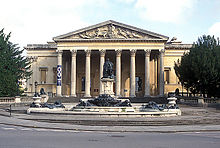
Bristol is home to two major institutions of higher education: the University of Bristol, a " redbrick" chartered in 1909, and the University of the West of England, formerly Bristol Polytechnic, which gained university status in 1992. In addition The University of Law has a campus in the city. Bristol also has two dedicated further education institutions, City of Bristol College and South Gloucestershire and Stroud College, and three theological colleges, Trinity College, Wesley College and Bristol Baptist College. The city has 129 infant, junior and primary schools, 17 secondary schools, and three city learning centres. It has the country's second highest concentration of independent school places, after an exclusive corner of north London. The independent schools in the city include Colston's School, Clifton College, Clifton High School, Badminton School, Bristol Grammar School, Redland High School, Queen Elizabeth's Hospital (the only all-boys school) and Red Maids' School, which claims to be the oldest girls' school in England, having been founded in 1634 by John Whitson.
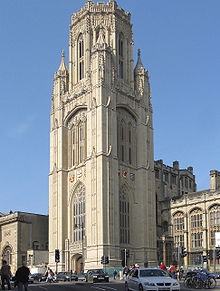
In 2005, the then Chancellor of the Exchequer recognised Bristol's ties to science and technology by naming it one of six "science cities", and promising funding for further development of science in the city, with a £300 million science park planned at Emersons Green. As well as research at the two universities, Bristol Royal Infirmary, and Southmead Hospital, science education is important in the city, with At-Bristol, Bristol Zoo, Bristol Festival of Nature and the Create Centre being prominent local institutions involved in science communication. The city has a history of scientific luminaries, including the 19th century chemist Sir Humphry Davy, who worked in Hotwells. Bishopston gave the world Nobel Prize winning physicist Paul Dirac for crucial contributions to quantum mechanics in 1933. Cecil Frank Powell was Melvill Wills Professor of Physics at Bristol University when he was awarded the Nobel prize for a photographic method of studying nuclear processes and associated discoveries in 1950. The city was the birthplace of Colin Pillinger, planetary scientist behind the Beagle 2 Mars-lander project, and was home to the neuropsychologist Richard Gregory, founder of the Exploratory, a hands-on science centre, precursor of at-Bristol. Initiatives such as the Flying Start Challenge help encourage secondary school pupils around the Bristol area to take an interest in Science and Engineering. Links with major aerospace companies promote technical disciplines and advance students' understanding of practical design. The Bloodhound SSC project, aiming to break the land speed record, is based at the Bloodhound Technology Centre on Bristol's harbourside.
Transport
Bristol has two principal railway stations. Bristol Temple Meads is near the centre and sees mainly First Great Western services including regular high speed trains to London Paddington as well as other local and regional services and CrossCountry trains. Bristol Parkway is located to the north of the city and is mainly served by high speed First Great Western services between Cardiff and London, and CrossCountry services to Birmingham and the North East. There is also a limited service to London Waterloo from Bristol Temple Meads, operated by South West Trains. There are also scheduled coach links to most major UK cities.
The city is connected by road on an east–west axis from London to West Wales by the M4 motorway, and on a north–southwest axis from Birmingham to Exeter by the M5 motorway. Also within the county is the M49 motorway, a short cut between the M5 in the south and M4 Severn Crossing in the west. The M32 motorway is a spur from the M4 to the city centre.
The city is served by Bristol Airport (BRS), at Lulsgate, which has seen substantial investments in its runway, terminal and other facilities since 2001.
Public transport in the city consists largely of its bus network, provided mostly by FirstGroup, formerly the Bristol Omnibus Company – other services are provided by Abus, Buglers, Ulink (Operated by Wessex Connect for the 2 Universities), and Wessex Connect. Buses in the city have been widely criticised for being unreliable and expensive, and in 2005 First was fined for delays and safety violations. Private car usage in Bristol is high, and the city suffers from congestion, which costs an estimated £350 million per year. Bristol is motorcycle friendly; the city allows motorcycles to use most of the city's bus lanes, as well as providing secure free parking. Since 2000 the city council has included a light rail system in its local transport plan, but has so far been unwilling to fund the project. The city was offered European Union funding for the system, but the Department for Transport did not provide the required additional funding. As well as support for public transport, there are several road building schemes supported by the local council, including re-routing and improving the South Bristol Ring Road. There are also three park and ride sites serving the city, supported by the local council. The central part of the city has water-based transport, operated by the Bristol Ferry Boat, Bristol Packet and Number Seven Boat Trips providing leisure and commuter services on the harbour.
Bristol's principal surviving suburban railway is the Severn Beach Line to Avonmouth and Severn Beach. The Portishead Railway was closed to passengers under the Beeching Axe, but was relaid for freight only in 2000–2002 as far as the Royal Portbury Dock with a Strategic Rail Authority rail-freight grant. Plans to relay a further three miles (5 km) of track to Portishead, a largely dormitory town with only one connecting road, have been discussed but there is insufficient funding to rebuild stations. Rail services in Bristol suffer from overcrowding and there is a proposal to increase rail capacity under the Greater Bristol Metro scheme.
Bristol was named "England's first 'cycling city'" in 2008, and is home to the sustainable transport charity Sustrans. It has a number of urban cycle routes, as well as links to National Cycle Network routes to Bath and London, to Gloucester and Wales, and to the south-western peninsula of England. Cycling has grown rapidly in the city, with a 21% increase in journeys between 2001 and 2005.
Twin cities
Bristol was among the first cities to adopt the idea of town twinning. In 1947 it was twinned with Bordeaux and then with Hannover, the first post-war twinning of British and German cities. Twinnings with Porto, Portugal (1984), Tbilisi, Georgia (1988), Puerto Morazan, Nicaragua (1989), Beira, Mozambique (1990) and Guangzhou, China (2001), have followed.

